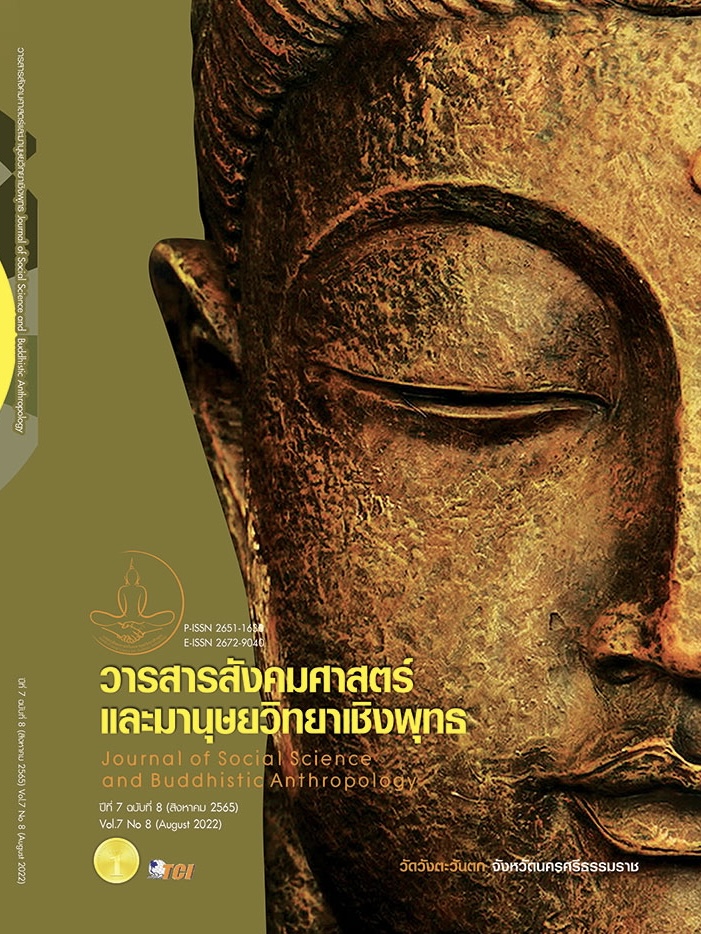THE APPLICATION OF WORK LIFE BALANCE FOR PRIVATE ORGANIZATION EMPLOYEES
Keywords:
Work-Life Balance, Private Organization Employee, Growth Mindset, Organizational Culture, 7 Habits of Highly Effective PeopleAbstract
This academic article aims to: 1) apply work-life balance of private organization employee. Work-life balance refers to a state in which a person can manage his or her work style in accordance with working conditions, health, leisure time, family life and other responsibilities. They can perfectly balance both the interests of the organization and self, including maintaining a balance of relationships with family and society. The application of work life balance of private organization employees uses Merrill & Merrill's conceptual framework which divides work-life balance into 5 areas as follows: 1) Work aspect; the application means to promote work or career to be something that drives creativity among employees 2) Family aspect; it is appropriate to allocate time for creating personal happiness that leads to success of living in society 3) Time aspect; the ability to allocate time which is very important in every aspect of life 4) Financial aspect; allocated savings is the tools that allows a person to live in the present and in the future that related to work, family and time 5) Intellectually aspect; the development for life to fulfill every aspect that make all parties satisfied. The causal factors affecting the work-life balance of private organization employees were the growth mindset, organizational culture and the seven habits of highly effective people. If the organization applied this concept to motivate and encourage their employees to have work life balance, it will gain more happiness at work and stressless from all causal factors that will lead to highly effectiveness organization.
References
คณะกรรมการเสริมสร้างความผูกพันองค์กร. (2564). สมดุลชีวิต 8 - 8 - 8 : สูตรสร้างความสุข สมดุล ให้กับชีวิตและการทำงาน (เอกสารคู่มือ). อุบลราชธานี: ศูนย์สุขภาพจิตที่ 10.
นิตินัย หมีสอาด. (2556). ความสัมพันธ์ระหว่างการบริหารสมดุลระหว่างชีวิตและการทำงานกับความผูกพันต่อองค์กรของพนักงาน. ใน สารนิพนธ์บริหารธุรกิจมหาบัณฑิต สาขาการบริหารธุรกิจ. มหาวิทยาลัยเทคโนโลยีราชมงคลธัญบุรี.
ปริณดา สมควร. (2556). ความสมดุลระหว่างชีวิตและการทำงานกับประสิทธิผลการปฏิบัติงานของข้าราชการตำรวจ กองบังคับการอํานวยการ สำนักงานตรวจคนเข้าเมือง. ใน สารนิพนธ์รัฐประศาสนศาสตรมหาบัณฑิต สาขารัฐประศาสนศาสตร์. มหาวิทยาลัยเกริก.
พิชิต เทพวรรณ์. (2556). ความสมดุลระหว่างชีวิตและการทำงาน. ใน วิทยานิพนธ์บริหารธุรกิจมหาบัณฑิต สาขาวิชาการจัดการ. มหาวิทยาลัยเชียงใหม่.
สมชัย ปราบรัตน์. (2561). ความสมดุลของชีวิตและทำงานของพนักงานในธุรกิจอุตสาหกรรมการผลิตประเภทอาหารแปรรูปบรรจุกระป๋อง: กรณีศึกษาเฉพาะ 3 บริษัทขนาดใหญ่ในจังหวัดสงขลา. ใน การประชุมหาดใหญ่วิชาการระดับชาติและนานาชาติ ครั้งที่ 9 (หน้า 528-529). สงขลา: มหาวิทยาลัยหาดใหญ่.
หทัยทิพย์ ลิ้วสงวนกุลธร. (2555). การศึกษาปัจจัยที่มีผลต่อสมดุลชีวิตกับการทำงาน กรณีศึกษาสถาบันคุ้มครองเงินฝาก. ใน สารนิพนธ์บริหารธุรกิจมหาบัณฑิต สาขาวิชาการจัดการทรัพยากรมนุษย์. มหาวิทยาลัยหอการค้าไทย.
Covey, S. R. (2012). The seven habits of highly effective people. New York: Simon and Schuster.
Dweck, C. S. (2012). Mindset: The new psychology of success. New York: Random House.
Haygroup. (2015). Engaging Hearts & Minds: Preparation for a Changing World. Retrieved December 1, 2020, from http://www.haygroup.com/
Hox, J. J. (2010). Multilevel Analysis: Techniques and Applications (2nd ed.). New York: Routledge.
Hyman, J. & Summers, J. (2004). Lacking balance? Work-life employment practices in the modern economy. Personnel Review, 33(4), 418-429.
Merrill & Merrill. (2003). Life Matter: Crating a dynamic balance of work, family, time and money. New York: McGraw-Hall.
Schroder, H.S. et al. (2014). The Role of Implicit Theories in MentalHealth Symptoms, Emotion Regulation, and Hypothetical Treatment Choices in College Students. Cognitive Therapy and Research, 39(2), 120-139.
Downloads
Published
How to Cite
Issue
Section
License
Copyright (c) 2022 Journal of Social Science and Buddhistic Anthropology

This work is licensed under a Creative Commons Attribution-NonCommercial-NoDerivatives 4.0 International License.








